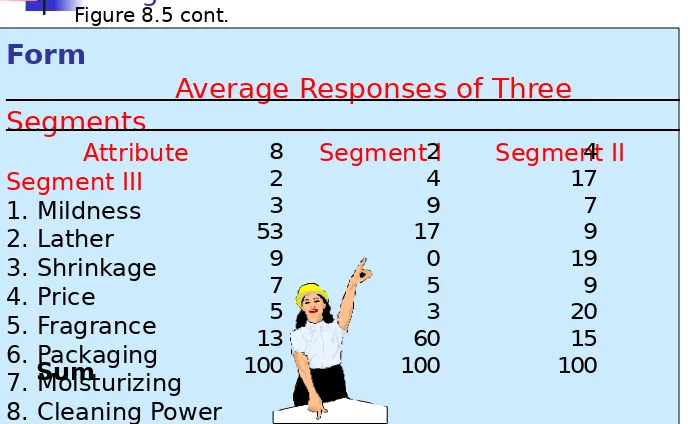Chapter Eight
Measurement and Scaling:
Fundamentals and
1) Overview
2) Measurement and Scaling
3) Primary Scales of Measurement
i. Nominal Scale
ii. Ordinal Scale
iii. Interval Scale
iv. Ratio Scale
Chapter Outline
5) Comparative Scaling Techniques
i. Paired Comparison
ii. Rank Order Scaling
iii. Constant Sum Scaling
iv. Q-Sort and Other Procedures
6) Verbal Protocols
9) Internet and Computer Applications 10) Focus on Burke
11) Summary
Measurement and Scaling
Measurement means assigning numbers or other symbols to characteristics of objects according to certain prespecified rules.
One-to-one correspondence between the
numbers and the characteristics being measured.
The rules for assigning numbers should be
standardized and applied uniformly.
Rules must not change over objects or time.
Scaling involves creating a continuum upon which measured objects are located.
Consider an attitude scale from 1 to 100. Each respondent is assigned a number from 1 to
The numbers serve only as labels or tags for
identifying and classifying objects.
When used for identification, there is a strict
one-to-one correspondence between the numbers and the objects.
The numbers do not reflect the amount of the
characteristic possessed by the objects.
The only permissible operation on the numbers
in a nominal scale is counting.
Only a limited number of statistics, all of which
are based on frequency counts, are
Illustration of Primary Scales of
A ranking scale in which numbers are assigned
to objects to indicate the relative extent to
which the objects possess some characteristic.
Can determine whether an object has more or
less of a characteristic than some other object, but not how much more or less.
Any series of numbers can be assigned that
preserves the ordered relationships between the objects.
In addition to the counting operation allowable
Primary Scales of Measurement
Interval Scale
Numerically equal distances on the scale represent
equal values in the characteristic being measured.
It permits comparison of the differences between
objects.
The location of the zero point is not fixed. Both the
zero point and the units of measurement are arbitrary.
Any positive linear transformation of the form y = a
+ bx will preserve the properties of the scale.
It is meaningful to take ratios of scale values.
Statistical techniques that may be used include all
of those that can be applied to nominal and ordinal data, and in addition the arithmetic mean, standard deviation, and other statistics commonly used in
Possesses all the properties of the nominal,
ordinal, and interval scales.
It has an absolute zero point.
It is meaningful to compute ratios of scale
values.
Only proportionate transformations of the form
y = bx, where b is a positive constant, are allowed.
All statistical techniques can be applied to
Techniques
A Comparison of Scaling
Techniques
Comparative scales involve the direct
comparison of stimulus objects. Comparative scale data must be interpreted in relative
terms and have only ordinal or rank order properties.
In noncomparative scales, each object is
scaled independently of the others in the
Small differences between stimulus objects
can be detected.
Same known reference points for all
respondents.
Easily understood and can be applied.
Involve fewer theoretical assumptions.
Tend to reduce halo or carryover effects from
Relative Disadvantages of Comparative
Scales
Ordinal nature of the data
Inability to generalize beyond the stimulus
A respondent is presented with two objects
and asked to select one according to some criterion.
The data obtained are ordinal in nature.
Paired comparison scaling is the most widely
used comparative scaling technique.
With n brands, [n(n - 1) /2] paired comparisons
are required
Under the assumption of transitivity, it is
Obtaining Shampoo Preferences
Using Paired Comparisons
Figure 8.3
Instructions: We are going to present you with ten
pairs of shampoo brands. For each pair, please indicate which one of the two brands of shampoo you would prefer for personal use.
aA 1 in a particular box means that the brand in that column was
preferred over the brand in the corresponding row. A 0 means that the row brand was preferred over the column brand. bThe number of
The most common method of taste testing is paired
comparison. The consumer is asked to sample two different
products and select the one with the most appealing taste. The test is done in private and a minimum of 1,000 responses is
considered an adequate sample. A blind taste test for a soft drink, where imagery, self-perception and brand reputation are very important factors in the consumer’s purchasing decision, may not be a good indicator of performance in the
marketplace. The introduction of New Coke illustrates this point. New Coke was heavily favored in blind paired
comparison taste tests, but its introduction was less than
successful, because image plays a major role in the purchase of Coke.
Comparative Scaling Techniques
Rank Order Scaling
Respondents are presented with several
objects simultaneously and asked to order or rank them according to some criterion.
It is possible that the respondent may dislike
the brand ranked 1 in an absolute sense.
Furthermore, rank order scaling also results in
ordinal data.
Only (n - 1) scaling decisions need be made in
Figure 8.4
Instructions: Rank the various brands of toothpaste in order of preference. Begin by picking out the one brand that you like most and assign it a number 1. Then find the second most preferred brand and assign it a number 2. Continue this procedure until you have ranked all the brands of toothpaste in order of preference. The least preferred brand should be assigned a rank of 10.
Brand Rank Order
Preference for Toothpaste Brands
Using Rank Order Scaling
Figure 8.4 cont.
Respondents allocate a constant sum of units,
such as 100 points to attributes of a product to reflect their importance.
If an attribute is unimportant, the respondent
assigns it zero points.
If an attribute is twice as important as some
other attribute, it receives twice as many points.
The sum of all the points is 100. Hence, the
Importance of Bathing Soap Attributes
Using a Constant Sum Scale
Figure 8.5
Instructions

